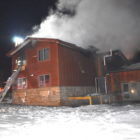-
Eye on Ohio joins international consortium recognizing news organizations who pass rigorous standards based on news audience research
Washington Post, Economist, dozens of local news sites among those in the Trust Project Eye on Ohio has always taken seriously the trust that our readers, viewers, and listeners place in us. For that reason, we have always made our financial information publicly available, been certified by nonprofit tracker Candid (formerly Guidestar), and posted our…
-
Sidebar: Crisis intervention specialists
By Cid Standifer In the videos where young children in crisis were handcuffed, while they had likely been through the basic 8-hour crisis response training, none of the officers who were first on the scene had been through the 40 hours of training required to become crisis intervention team specialists. The Marshall Project and Eye…
-
Ohio Civil Rights Commission finds probable cause of disability discrimination in Dublin case
Mysterious arson remains unsolved This article provided by Eye on Ohio, the nonprofit, nonpartisan Ohio Center for Journalism in conjunction with WOSU 89.7 NPR News. Please join Eye on Ohio’s free mailing list or download the WOSU Public Media Mobile app as this helps provide more public service reporting to the community. By Lucia Walinchus…
-
Regulators’ foot-dragging on public records hides the full story behind Ohio’s utility corruption scandal
Documents produced at the end of July shed light on Sam Randazzo’s role at the Public Utilities Commission of Ohio. But more documents before and after his tenure still haven’t been produced. This article is provided by Eye on Ohio, the nonprofit, nonpartisan Ohio Center for Journalism, in partnership with the nonprofit Energy News Network.…
-
Former Ohio regulator linked to $4 million payoff directed agency to limit response to FirstEnergy corruption
Former PUCO Chair Sam Randazzo shaped agency responses to HB 6 scandal: ‘Proactive’ show-cause action followed only after bad publicity. Randazzo and others closely tracked legislative actions as well. This article is provided by Eye on Ohio, the nonprofit, nonpartisan Ohio Center for Journalism in partnership with the nonprofit Energy News Network. Please join the…
-
FirstEnergy’s admissions feed critics’ call for big-picture regulatory oversight and review
The company’s revelations about Ohio’s largest corruption case raise questions about the integrity of the regulatory process and its piecemeal approach to reviewing utility spending. This story is from the Energy News Network in collaboration with Eye on Ohio, the nonprofit, nonpartisan Ohio Center for Journalism. Please join Eye on Ohio’s free mailing list or…
-
Ohio restaurateurs hope winter and COVID won’t kill them off
This article is from Eye on Ohio, the nonprofit, nonpartisan Ohio Center for Journalism. Please join their free mailing list, as this helps provide more public service reporting. By Grant Segall At the Academy Tavern in Cleveland last week, Missy and Wilson Heller shared a table but not a comfort level. “I’m freaked out,” Missy…
-
Capacity inches downward as first Ohioans get COVID vaccine
The Ohio Department of Health released more hospital capacity and equipment numbers yesterday, as the first Ohioans received their first vaccine doses and the U.S. death toll exceeded 300,000.
-
“It literally consumes everything I do”: Ohioans desperate to reach unemployment hotline as calls dropped, claims languish
By Cid Standifer Marcia Gassaway was in the first wave of Ohioans put out of work by COVID-19. The single mom from Cleveland went to the emergency room on March 15. Due to her coronavirus-like symptoms, doctors ordered that she be quarantined at a special facility. Now, she’s recovering at home with her children, calling…
-
Ohio electric vehicle legislation pushed to back burner amid pandemic response
In recent years, the state has encouraged local electric vehicle manufacturing while also encouraging fossil fuel production; shaky economy spells more uncertainty ahead By Kathiann M. Kowalski A set of bills aimed at promoting electric vehicles in Ohio is among the state legislation on hold across the country as lawmakers grapple with the coronavirus pandemic.…









